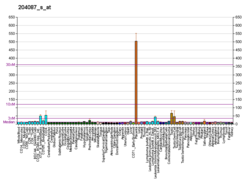
KNOWPIA
WELCOME TO KNOWPIA
Summary
Sodium-dependent multivitamin transporter is a protein that in humans is encoded by the SLC5A6 gene.[5][6][7]
| SLC5A6 | |||||||||||||||||||||||||||||||||||||||||||||||||||
|---|---|---|---|---|---|---|---|---|---|---|---|---|---|---|---|---|---|---|---|---|---|---|---|---|---|---|---|---|---|---|---|---|---|---|---|---|---|---|---|---|---|---|---|---|---|---|---|---|---|---|---|
| Identifiers | |||||||||||||||||||||||||||||||||||||||||||||||||||
| Aliases | SLC5A6, SMVT, solute carrier family 5 member 6, NERIB | ||||||||||||||||||||||||||||||||||||||||||||||||||
| External IDs | OMIM: 604024 MGI: 2660847 HomoloGene: 23277 GeneCards: SLC5A6 | ||||||||||||||||||||||||||||||||||||||||||||||||||
| |||||||||||||||||||||||||||||||||||||||||||||||||||
| |||||||||||||||||||||||||||||||||||||||||||||||||||
| |||||||||||||||||||||||||||||||||||||||||||||||||||
| |||||||||||||||||||||||||||||||||||||||||||||||||||
| |||||||||||||||||||||||||||||||||||||||||||||||||||
| Wikidata | |||||||||||||||||||||||||||||||||||||||||||||||||||
| |||||||||||||||||||||||||||||||||||||||||||||||||||
The SMVT is a transporter for pantothenic acid (vitamin B5) and biotin (vitamin B7) at the blood–brain barrier.[8] It is also a transporter for alpha lipoic acid[9] and iodide. Transport of these nutrients is competitive[10] and a surplus of a given nutrient may saturate the transporter and prevent the uptake of other nutrients.
References edit
- ^ a b c GRCh38: Ensembl release 89: ENSG00000138074 – Ensembl, May 2017
- ^ a b c GRCm38: Ensembl release 89: ENSMUSG00000006641 – Ensembl, May 2017
- ^ "Human PubMed Reference:". National Center for Biotechnology Information, U.S. National Library of Medicine.
- ^ "Mouse PubMed Reference:". National Center for Biotechnology Information, U.S. National Library of Medicine.
- ^ Prasad PD, Wang H, Kekuda R, Fujita T, Fei YJ, Devoe LD, et al. (March 1998). "Cloning and functional expression of a cDNA encoding a mammalian sodium-dependent vitamin transporter mediating the uptake of pantothenate, biotin, and lipoate". The Journal of Biological Chemistry. 273 (13): 7501–6. doi:10.1074/jbc.273.13.7501. PMID 9516450.
- ^ Wang H, Huang W, Fei YJ, Xia H, Yang-Feng TL, Leibach FH, et al. (May 1999). "Human placental Na+-dependent multivitamin transporter. Cloning, functional expression, gene structure, and chromosomal localization". The Journal of Biological Chemistry. 274 (21): 14875–83. doi:10.1074/jbc.274.21.14875. PMID 10329687.
- ^ "Entrez Gene: SLC5A6 solute carrier family 5 (sodium-dependent vitamin transporter), member 6".
- ^ Uchida Y, Ito K, Ohtsuki S, Kubo Y, Suzuki T, Terasaki T (July 2015). "Major involvement of Na(+) -dependent multivitamin transporter (SLC5A6/SMVT) in uptake of biotin and pantothenic acid by human brain capillary endothelial cells". Journal of Neurochemistry. 134 (1): 97–112. doi:10.1111/jnc.13092. PMID 25809983. S2CID 37721695.
- ^ Quick M, Shi L (2015). "The sodium/multivitamin transporter: a multipotent system with therapeutic implications". Vitamins and Hormones. 98: 63–100. doi:10.1016/bs.vh.2014.12.003. PMC 5530880. PMID 25817866.
- ^ Chirapu SR, Rotter CJ, Miller EL, Varma MV, Dow RL, Finn MG (31 March 2013). "High specificity in response of the sodium-dependent multivitamin transporter to derivatives of pantothenic acid". Current Topics in Medicinal Chemistry. 13 (7): 837–42. doi:10.2174/1568026611313070006. PMID 23578027.
Further reading edit
- Prasad PD, Wang H, Huang W, Fei YJ, Leibach FH, Devoe LD, Ganapathy V (June 1999). "Molecular and functional characterization of the intestinal Na+-dependent multivitamin transporter". Archives of Biochemistry and Biophysics. 366 (1): 95–106. doi:10.1006/abbi.1999.1213. PMID 10334869.
- Zempleni J, Steven Stanley J, Mock DM (August 2001). "Proliferation of peripheral blood mononuclear cells causes increased expression of the sodium-dependent multivitamin transporter gene and increased uptake of pantothenic acidopen star". The Journal of Nutritional Biochemistry. 12 (8): 465–473. doi:10.1016/S0955-2863(01)00162-0. PMID 11834205.
- Dey S, Subramanian VS, Chatterjee NS, Rubin SA, Said HM (March 2002). "Characterization of the 5' regulatory region of the human sodium-dependent multivitamin transporter, hSMVT". Biochimica et Biophysica Acta. 1574 (2): 187–92. doi:10.1016/s0167-4781(02)00226-9. PMID 11955628.
- Balamurugan K, Ortiz A, Said HM (July 2003). "Biotin uptake by human intestinal and liver epithelial cells: role of the SMVT system". American Journal of Physiology. Gastrointestinal and Liver Physiology. 285 (1): G73-7. doi:10.1152/ajpgi.00059.2003. PMID 12646417.
- Balamurugan K, Vaziri ND, Said HM (April 2005). "Biotin uptake by human proximal tubular epithelial cells: cellular and molecular aspects". American Journal of Physiology. Renal Physiology. 288 (4): F823-31. doi:10.1152/ajprenal.00375.2004. PMID 15561972.
- Otsuki T, Ota T, Nishikawa T, Hayashi K, Suzuki Y, Yamamoto J, et al. (2007). "Signal sequence and keyword trap in silico for selection of full-length human cDNAs encoding secretion or membrane proteins from oligo-capped cDNA libraries". DNA Research. 12 (2): 117–26. doi:10.1093/dnares/12.2.117. PMID 16303743.
- Luo S, Kansara VS, Zhu X, Mandava NK, Pal D, Mitra AK (2006). "Functional characterization of sodium-dependent multivitamin transporter in MDCK-MDR1 cells and its utilization as a target for drug delivery". Molecular Pharmaceutics. 3 (3): 329–39. doi:10.1021/mp0500768. PMC 2553563. PMID 16749865.
- Reidling JC, Nabokina SM, Said HM (January 2007). "Molecular mechanisms involved in the adaptive regulation of human intestinal biotin uptake: A study of the hSMVT system". American Journal of Physiology. Gastrointestinal and Liver Physiology. 292 (1): G275-81. doi:10.1152/ajpgi.00327.2006. PMID 16959947. S2CID 575953.
- Reidling JC, Said HM (April 2007). "Regulation of the human biotin transporter hSMVT promoter by KLF-4 and AP-2: confirmation of promoter activity in vivo". American Journal of Physiology. Cell Physiology. 292 (4): C1305-12. doi:10.1152/ajpcell.00360.2006. PMID 17135299.







